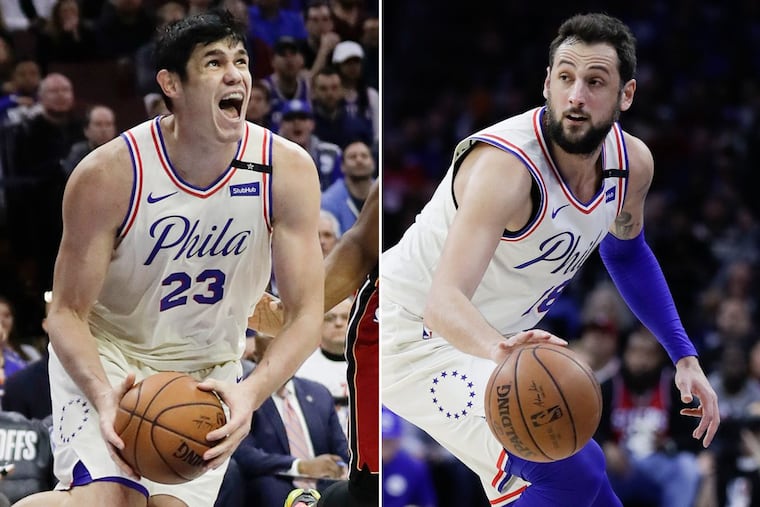Analytics research led Sixers to Marco Belinelli and Ersan Ilyasova signings
Before the 76ers signed their sharpshooting vets, they made sure the numbers added up.

In February, Bryan Colangelo realized he would need reinforcements to help his Sixers make a stretch run to the playoffs and beyond. He liked the idea of adding Marco Belinelli and Ersan Ilyasova, veterans who were likely to be released by the Hawks.
But he had to check with his numbers guys first.
When the Sixers hired Colangelo to run the team in 2016, one of Colangelo's priorities was to amplify the presence of analytics and sports science. Within a year he had turned a three-man staff into a stable of 10 geniuses. By February, they could tell him how Ilyasova defended every other power forward in the NBA, and they could tell him that Belinelli's sometimes-wild shot selection is, for him, an efficient strategy.
So, after checking the numbers, he got his men. The play of Belinelli and Ilyasova pushed the Sixers to a 17-game winning streak, including the team's first playoff win since 2012.
"Analytics are clearly a big part of our evidence-based decision-making process," Colangelo said, "and yes, both players were viewed favorably in that regard."
The same data sets — culled from high-definition cameras installed at every NBA arena that track player movement and efficiency, then synthesized by the Sixers' home-grown computer programs — warned Colangelo off other players he might have acquired as poorer fits. Then again, so did character and maturity issues.
The 30-year-old Ilyasova played 53 games for the Sixers last season and served as a superb mentor for rookie Dario Saric. Belinelli, 32, played a season for Colangelo in Toronto and later spent two seasons with the Spurs, a team with which Sixers coach Brett Brown has deep roots.
"The professionalism, experience and moxie that both players bring is where the relationships and familiarity with the players influences or informs us, non-analytically," Colangelo said.
He continually seeks high-character, analytically efficient players to sign. That's why he lavished $23 million on shooter JJ Redick this summer even though Redick, a 33-year-old workaholic health nut, had never made that much money in any three seasons combined. It's why Colangelo reunited with former Raptors big man Amir Johnson, who is 30 and who, after 13 seasons, is always in the right place at the right time — something analytics records predicts.
Colangelo will use the same criteria when free agency begins this summer. Soon, he hopes to be able to apply mountains of data to future Sixers drafts, especially since that exercise will become harder and harder as the Sixers drift away from the top of the lottery, where they spent the last five years.
For now, when they're looking for the next Joel Embiid in college or the next Dario Saric overseas, the Sixers mainly rely on traditional stats and the ol' eye test.
"Truthfully, the available data sets on draft prospects are less robust, so modeling or projecting based on historical evidence is more of a focus," Colangelo said. "I know that there is a push, industry-wide, to install cameras both at the college and international levels, so we will potentially have more comparative data to rely on."
The Sixers will be ready when that happens. In the meantime, they're improvising.
They've already begun sifting through candidates for an 11th position on the staff: a draft analytics expert.
"They'll leverage data and video on prospects," said Sixers analytics chief Alex Rucker. "They need to love basketball. Love video. And be able to make sense of it independently."
The Process gets deeper and deeper.